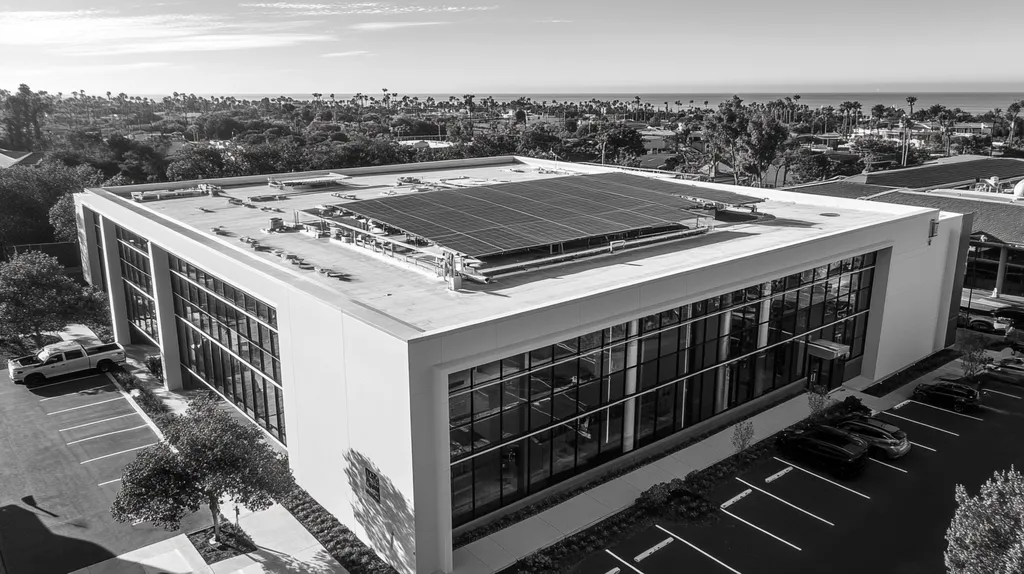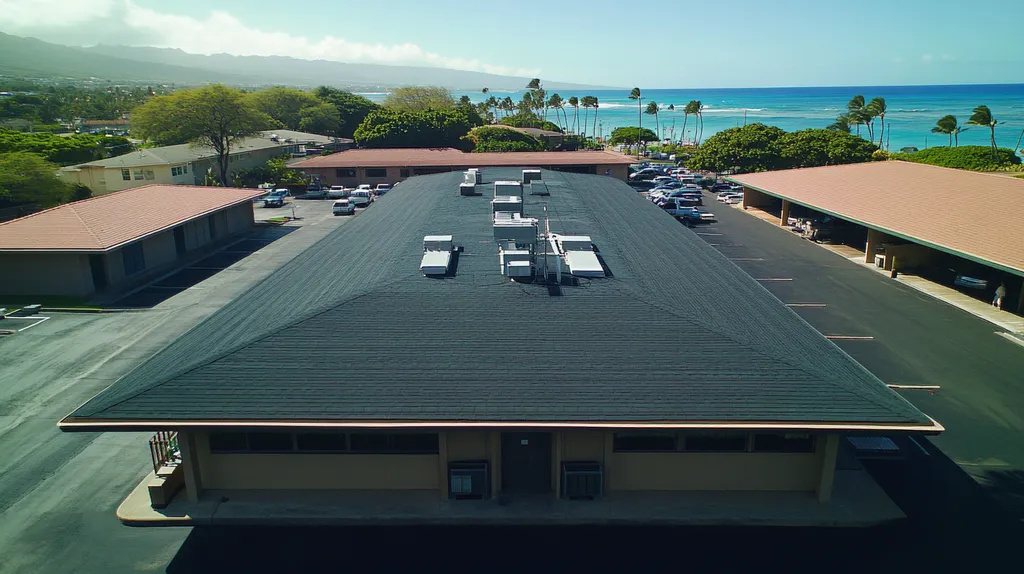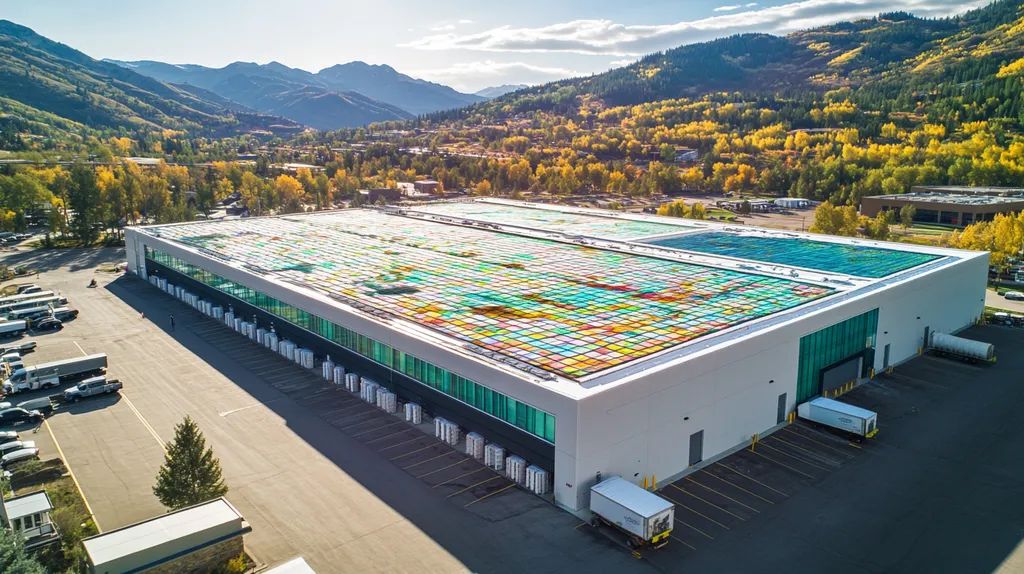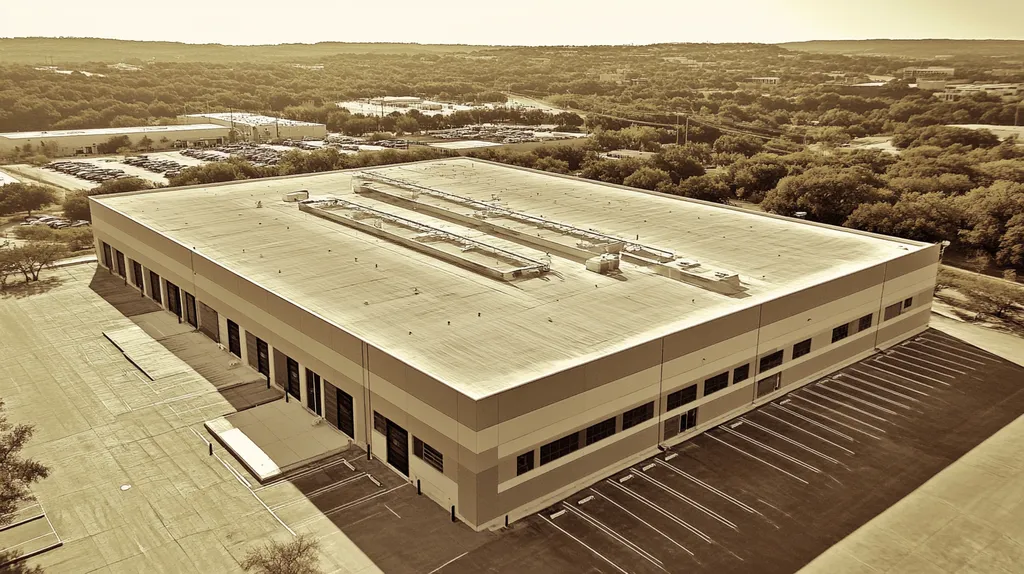Every year, industrial roof leaks cost U.S. businesses over $1.5 billion in damaged inventory, equipment failures, and operational disruptions. Despite these staggering losses, many facility managers continue to rely on outdated detection methods and misguided assumptions about roof maintenance.
The consequences of delayed leak response extend far beyond simple water damage, threatening structural integrity and workplace safety while exposing organizations to significant liability risks.
This analysis examines common misconceptions about industrial roof leaks, their practical implications, and evidence-based solutions that enable faster detection and more effective response strategies.
SECTION 1: COMMON MISCONCEPTIONS
Leaks in industrial roofs can cause significant damage, disrupt operations, and create safety risks. A common misconception among property managers is that roof leaks are only a concern for older structures. Many also believe that visual inspections are sufficient to detect all issues and that DIY methods are effective for managing leaks. These assumptions can lead to costly mistakes by ignoring critical factors and industry best practices.
Leaks Only Occur in Old Roofs
It’s a prevalent myth that only aging roofs are prone to leaks. However, new roofs are not invulnerable and can develop issues due to improper installation or material defects. For example, even a recently constructed facility may face leaks if the installation team did not adhere to correct procedures.
While modern roofing materials are designed for durability, they are still susceptible to leaks caused by severe weather or inadequate maintenance. Property managers must recognize that investing in a new roof does not eliminate the risk of leaks.
Additionally, fluctuating environmental factors can place stress on roofing materials. This highlights the necessity of regular assessments, even for newer roofs, to pinpoint and address potential leaks early on. Failing to do so can result in significant long-term damage.
In conclusion, vigilance is essential for every roof, regardless of age, to ensure its integrity and protect against leaks.
Visual Inspections Are Enough
A widespread misconception is that visual inspections alone can detect all roofing issues. While these checks are useful, they often miss underlying problems that could lead to serious leaks. For instance, moisture might accumulate beneath the roof surface, weakening materials without showing any external signs.
Relying solely on visual inspections can increase the chances of overlooking critical maintenance needs. A thorough assessment should include advanced techniques like thermal imaging or moisture surveys, which can identify hidden leaks effectively.
Employing comprehensive evaluation methods ensures that issues missed during visual inspections are addressed promptly. Investing in such strategies not only facilitates timely repairs but also enhances the overall performance of the roof.
Property managers should prioritize detailed inspections to maintain a leak-free roofing system.
DIY Leak Detection is Effective
Many property owners underestimate the complexity involved in leak detection, wrongly believing that DIY methods are sufficient for identifying roofing problems. Approaching this task without the proper tools and expertise can lead to incorrect assessments and safety risks.
While some basic leak detection methods exist, professionals are equipped with advanced tools like moisture meters and infrared cameras that can identify subtle water infiltration that remains hidden to the untrained eye.
Moreover, untrained individuals may inadvertently cause additional damage during DIY inspections. This risk is heightened when attempting to access rooftops or troubleshoot complex issues without appropriate safety measures.
In short, depending on DIY leak detection can result in costly oversights. Hiring a professional ensures a thorough evaluation, ultimately safeguarding the roof’s long-term health.
SECTION 2: PRACTICAL IMPLICATIONS
Prompt attention to leaks in industrial roofs is critical for ensuring a safe and efficient working environment. Delayed leak detection can culminate in severe structural damage and hefty repair costs. In fact, nearly 30% of commercial property owners have reported extensive damage stemming from undetected leaks, resulting in increased financial burdens and operational disruptions.
Delayed Detection and Its Consequences
When leaks go undiscovered, minor issues can become major problems. Water intrusion can weaken roofing materials and compromise the overall structural integrity. A single hidden leak may lead to rotting wood, rusting steel, and, ultimately, necessitate a complete roof replacement.
This escalation not only drives up repair costs but also leads to longer work stoppages. Facilities that delay repairs risk unauthorized access, creating security vulnerabilities. What starts as a scheduled maintenance task can quickly transform into an emergency response situation, complicating financial planning.
Moreover, persistent leaks can turn workplaces hazardous. Mold and mildew thrive in damp conditions, posing serious health risks to employees. Such unforeseen issues can lead to increased absenteeism and liability challenges for property managers.
In summary, delaying leak repairs can shift small repairs into costly crises, highlighting the importance of early detection and prompt action.
Impact on Building Integrity and Safety
The repercussions of undetected roof leaks extend far beyond the roof itself. Every leak threatens not just the roofing system but the entire structure of the building. Over time, water can infiltrate critical structural components like beams and trusses, leading to decay and potentially catastrophic failures.
Safety becomes a top priority, as water seeping through roofs can create slippery surfaces and foster bacterial growth. This jeopardizes the well-being of employees and could also expose property managers to litigation for negligence.
In addition, roof leaks can harm insulation and energy efficiency. Wet insulation fails to perform adequately, causing heating and cooling systems to overwork. This inefficiency leads to higher utility bills, draining resources that could be better allocated elsewhere.
Thus, safeguarding structural integrity and employee safety necessitates a rapid response to roofing leaks, emphasizing the need for consistent inspections and proactive maintenance.
Disruption to Business Operations
Leaks in industrial roofs can cause significant interruptions to business operations. When a leak is detected, it often results in immediate repair work, which can halt production and disrupt workflows. These extensive repairs may take days to resolve, leading to lost revenue and frustrated employees.
Beyond immediate operational setbacks, leaking roofs can threaten equipment and inventory. Sensitive machinery exposed to moisture can suffer damage, leading to costly replacements and repairs. This compounded financial loss underscores the urgency of addressing leaks as soon as they are identified.
Additionally, interruptions in operations can harm customer relationships. For companies that rely on delivering products on time, delays caused by roofing issues can erode client trust and satisfaction, adversely affecting long-term revenue.
To summarize, prompt attention to leaks is essential to avoid disruptions that ripple through an organization, negatively impacting productivity and profitability.
SECTION 3: COST OF MISINFORMATION
Failing to address leaks in industrial roofs can trigger significant financial repercussions. A minor crack may seem insignificant, but it can lead to comprehensive damage far exceeding initial repair costs. With repair expenses on the rise, property managers must acknowledge the seriousness of leaks. This section outlines three key financial burdens arising from misinformation: undetected leaks, escalating long-term repair costs, and increased legal liabilities.
Financial Burden of Undetected Leaks
Undetected leaks can stealthily amplify issues and drastically inflate repair costs. Research shows that neglecting a leak for just six months may boost repair expenses by up to 40%. This is largely attributed to structural damage and the deterioration of roofing materials, which require additional repairs.
Moreover, water intrusion can damage not only the roof but also vital internal structures like electrical systems and machinery. As these unforeseen challenges arise, facility managers often face emergency repairs that strain their budgets.
Additionally, compromised insulation due to leaks can result in higher energy costs. As leaks worsen, heating and cooling systems must exert more effort, leading to skyrocketing utility bills. Proactive leak management is crucial to mitigate these financial burdens effectively.
Long-Term Maintenance and Repair Costs
Ineffective leak management can yield long-term costs that overshadow initial repair expenses. Maintaining a damaged roof often becomes more complicated and time-consuming, requiring more frequent maintenance schedules that strain resources and inflate budgets.
Furthermore, a deteriorating roof may lead to secondary problems necessitating extensive interventions, such as mold growth resulting from persistent leaks. The remediation costs from such issues can be substantial.
Ultimately, these ongoing repair needs accumulate over time. Property managers may find ongoing expenditures surpassing early repair estimates. Thus, budgeting for regular inspections and timely repairs is critical for effective cost management.
Potential for Litigation and Liability
Neglecting roofing leaks exposes facilities to potential legal consequences. If water damage disrupts tenant operations or causes injury, property owners risk facing lawsuits. The financial implications of these legal claims can be severe, impacting both finances and reputation.
Insurance claims related to undetected leaks can also become contentious. Insurers may scrutinize claims, questioning the lack of preventative measures taken, potentially leading to denied claims and unexpected out-of-pocket costs for property owners.
Additionally, public relations challenges may arise when leaks cause tenant discomfort or operational disruptions. Damage to reputation can result in tenant turnover and difficulties in attracting new clients. A proactive approach to leak management acts as a safeguard against these potential pitfalls.
SECTION 4: REALITY CHECK
Roof leaks are not merely an inconvenience; they threaten the integrity of industrial operations. According to the National Roofing Contractors Association, 45% of commercial property owners will experience a roof leak at some point. The potential for lost productivity, damage to inventory, and the financial burden of repairs makes swift action essential. Understanding the common causes of leaks and the importance of early detection empowers property managers to safeguard their assets.
The Inevitability of Roof Leaks
Recognizing that roof leaks are inevitable can save property managers from significant challenges down the road. All roofs, regardless of materials used, will encounter wear and tear as they age. Weather extremes such as intense rain and freezing temperatures exacerbate existing vulnerabilities, increasing the likelihood of leaks.
Even newly installed roofs are not immune. Errors during installation, insufficient maintenance, or the use of substandard materials can create conditions conducive to leaks. Consequently, regular inspections are not just beneficial; they are essential for preserving roof integrity.
Remaining unaware of the leak potential can lead to severe complications. An unnoticed small leak can quickly escalate into a major failure, creating operational disruptions and financial consequences. This understanding prompts property managers to adopt preventative measures.
Ultimately, acknowledging the inevitability of roof leaks fosters a proactive approach to roof management, helping mitigate risks over the lifespan of industrial roofing systems.
Common Causes of Industrial Roof Leaks
Multiple factors contribute to leaks in industrial roofs. Among the most frequent are deteriorated seams, punctures, and flashing failures, which can compromise the roof’s ability to remain watertight.
Deteriorated seams typically occur due to thermal expansion and contraction. This movement can cause seams to separate, creating pathways for water penetration. Regular inspections that focus on seam integrity can catch these vulnerabilities early.
Punctures from falling debris or careless maintenance actions present another significant risk for leaks. These openings create direct access for water intrusion, underscoring the need for training among maintenance staff regarding potential damage during routine tasks.
Flashing failures, especially around rooftop penetrations, are common culprits as well. Over time, flashing may wear down and lose its effectiveness. Promptly identifying and repairing flashing issues is crucial for effective leak prevention.
Importance of Early Leak Detection
Early detection of roof leaks can save property managers time, money, and stress. The sooner a leak is identified, the less extensive the damage will be. A seemingly insignificant leak can lead to issues like mold growth, structural damage, and ultimately costly repairs.
Employing technology, such as infrared scanning, can reveal moisture trapped beneath roofing surfaces. This proactive approach allows facility managers to tackle issues before they escalate. Regular inspections should be scheduled, particularly after severe weather events, to maintain roof health.
Training staff to recognize warning signs such as discoloration on ceilings, water stains, or damp odors is equally vital. Immediate action on these indicators can prevent further damage. Developing a thorough response plan ensures that leaks are addressed swiftly, minimizing disruption.
In a climate where every operational hour is crucial, timely intervention becomes key. Establishing a routine for leak detection safeguards the investment in the roof and upholds productivity levels across the facility. Regular inspections serve as a fundamental component of a comprehensive roofing maintenance strategy, ensuring long-lasting roof performance and operational efficiency (source: Storific).
SECTION 5: EVIDENCE-BASED ALTERNATIVES
Quickly addressing industrial roof leaks is vital to preventing costly damage and operational interruptions. Research indicates that unresolved leaks can inflate repair costs by up to 20% over time. This section highlights three advanced detection methods—infrared roof leak detection, electronic leak detection, and drone inspections—that can significantly improve leak response and ultimately protect valuable assets.
Infrared Roof Leak Detection
Infrared roof leak detection utilizes thermal imaging to uncover hidden moisture within roofing materials. This cutting-edge technique visualizes temperature fluctuations, which signal wet insulation or water accumulation. By employing infrared cameras, property managers can detect issues promptly, minimizing the need for invasive methods.
This technology not only accelerates assessments in emergencies but also reduces the chance of overlooking leaks that traditional inspections might miss. Studies show that infrared detection can significantly lower the risk of extensive damage over time.
Flexible scheduling is another advantage, as infrared inspections can be conducted at any time, day or night. However, it is crucial to supplement infrared findings with site evaluations for a complete understanding of the roof’s condition.
Incorporating this method enables managers to make informed choices regarding repairs, ultimately extending the lifespan of the roof.
Electronic Leak Detection Methods
Electronic leak detection methods operate by sending low-voltage electrical currents through roofing membranes to identify leaks. This precise technology can uncover inconsistencies indicating breaches, allowing for swift action.
Ideal for flat roofs where leaks can be particularly elusive, electronic methods expedite detection, significantly cutting the time and costs associated with prolonged leak presence. Facilities using this technology have found leak remediation costs decrease by up to 30%.
Additionally, integrating electronic detection into routine maintenance schedules facilitates proactive monitoring, identifying leaks early and preventing emergency repairs. This strategy helps capture current issues and spot wear before it escalates into problems.
Overall, electronic leak detection streamlines repair processes and mitigates risks associated with unmonitored water intrusion.
Drone Inspections for Roof Monitoring
Drone inspections are transforming roof monitoring, offering aerial perspectives that traditional methods cannot match. Equipped with high-resolution cameras and thermal imaging tools, drones conduct thorough assessments efficiently.
This technology empowers property managers to obtain real-time data regarding roof conditions, allowing them to address issues immediately. Facilities utilizing drone inspections often report dramatic improvements in efficiency, completing evaluations in less than half the usual time.
Moreover, drones can access hard-to-reach areas safely, minimizing risks to personnel and reducing labor costs. This increased inspection frequency enhances the overall condition of roofing systems.
Embracing drone technology is an investment that leads to long-term savings and proactive maintenance, significantly reducing the likelihood of unexpected water damage and expensive repairs.
SECTION 6: TEST AND VERIFY
Detecting and verifying leaks in industrial roofs is a matter of urgency. Studies indicate that undetected leaks can lead to over $75,000 in damages, product loss, and operational disruptions. Property managers must have a firm grasp of the benefits and limitations of various leak detection methods to make informed decisions quickly. This section explores effective testing techniques that are essential for reducing long-term costs and preserving roof durability.
Flood Testing and Its Limitations
Flood testing is a widely used technique for identifying leaks in flat roofing systems. This method involves flooding specific roof sections with water and monitoring for leaks. While it provides immediate results, it does come with notable drawbacks.
Firstly, the weight of water can stress already compromised roofing materials, potentially causing further damage. This strain might exacerbate existing weaknesses, leading to more significant issues down the line.
Moreover, this approach only uncovers leaks in areas that are submerged. Hidden leaks lurking behind walls or beneath insulation may escape detection, leading to costly surprises later.
For optimal results, flood testing should be used in conjunction with other detection methods. This will provide a more comprehensive picture of roof health and potential vulnerabilities.
High and Low Voltage Leak Detection
High and low voltage leak detection methods represent a technological leap in locating roofing problems. These systems use electrical currents to pinpoint moisture intrusion, making them effective tools for property managers.
The high voltage method sends an electrical signal across the roof membrane. It identifies compromised areas by establishing a conductive path, particularly useful for larger commercial roofs.
On the other hand, low voltage leak detection offers a more subtle approach while still effectively identifying moisture issues. This method is ideal for sensitive areas, such as those around electrical systems.
By accurately identifying leak sources, both technologies save time and reduce unnecessary repair costs. However, it is essential for trained professionals to interpret the results correctly to ensure appropriate follow-up actions.
Dec Scanning for Moisture Detection
Dec scanning is a specialized technique used to assess moisture levels within roofing systems through infrared technology. It detects temperature differences that indicate trapped moisture without invasive procedures.
This non-destructive method allows property managers to visualize moisture issues without tearing apart roofing materials. By pinpointing areas with excessive moisture, targeted repairs can be made swiftly.
However, dec scanning should complement other detection techniques for maximum effectiveness. Proper calibration and interpretation are necessary to avoid misleading readings.
Incorporating dec scanning into a comprehensive roofing maintenance plan enables proactive management of potential leaks, ultimately preserving roof integrity and extending its lifespan.
The Bottom Line
Industrial roof leaks cost U.S. businesses over $1.5 billion annually, yet many facilities continue to rely on outdated detection methods that leave them vulnerable to catastrophic damage.
The evidence is clear: visual inspections alone miss 40% of developing leaks, while proper electronic detection methods can reduce repair costs by up to 30%.
Modern technologies like infrared scanning, electronic leak detection, and drone monitoring now offer facility managers unprecedented capabilities to identify and address leaks before they escalate into major issues.
Moving forward, property managers must abandon reactive approaches in favor of proactive monitoring strategies that leverage these advanced detection methods.
The cost of inaction far exceeds the investment in proper leak detection, making rapid response protocols essential for protecting both assets and operations.
FREQUENTLY ASKED QUESTIONS
Q. Are industrial roofs more prone to leaks than commercial roofs?
A. The likelihood of leaks typically depends on several factors, including materials and installation quality, rather than the roof type itself. Both industrial and commercial roofs can face similar risks if not properly maintained. Regular inspections are crucial for all roofing types to identify potential vulnerabilities early.
Q. How often should I inspect my commercial roof for leaks?
A. It’s recommended to inspect your commercial roof at least twice a year, ideally in the spring and fall. Following severe weather events, such as storms or heavy snowfall, additional inspections should occur. Regular evaluations help catch leaks early before they escalate into costly repairs.
Q. Can I rely on visual inspections for my industrial roof?
A. While visual inspections can provide valuable insights, they may miss hidden issues like internal water buildup. Routine assessments should ideally include advanced techniques such as thermal imaging to detect underlying problems that could lead to significant leaks.
Q. How do leaks affect worker safety in industrial buildings?
A. Roof leaks can create hazardous conditions, such as wet surfaces that increase slip and fall risks. Additionally, prolonged water exposure can lead to mold growth, which can pose health risks to employees. Ensuring timely leak repairs enhances overall workplace safety and minimizes liability risks.
Q. What are the costs associated with repairing industrial roof leaks?
A. Repair costs vary widely based on the leak’s extent and required materials, averaging from a few hundred to several thousand dollars. Factors like the complexity of the repair, roof type, and labor costs can significantly impact the final expense. Early detection can help minimize these costs.
Q. What preventive measures can I take for my commercial roof?
A. Implementing a regular maintenance schedule that includes inspections, debris removal, and timely repairs will help prevent major issues. Additionally, ensuring proper drainage and adhering to recommended material practices can help mitigate leak risks. Proactive management extends your roof’s lifespan and protects against leaks.
Q. When should I contact a professional for my industrial roof?
A. Contact a professional immediately if you notice visible signs of leaks, such as water stains or damp areas. Additionally, if regular inspections reveal potential vulnerabilities, seeking expert assessment is crucial. Timely involvement from professionals can prevent minor issues from escalating into substantial repairs.











